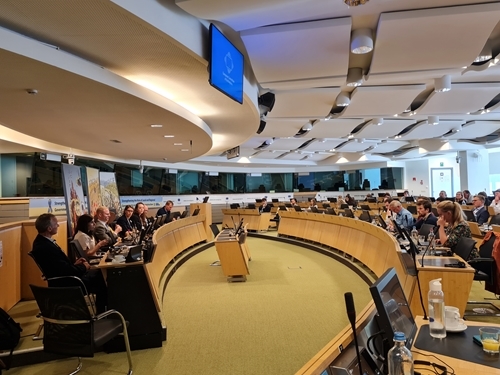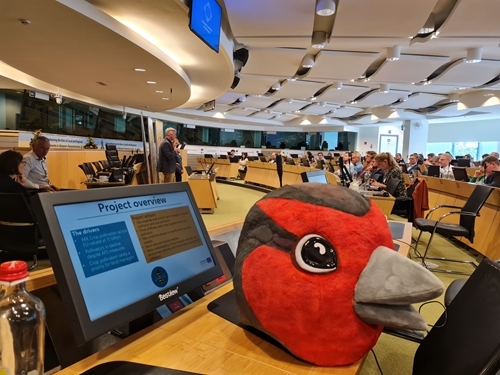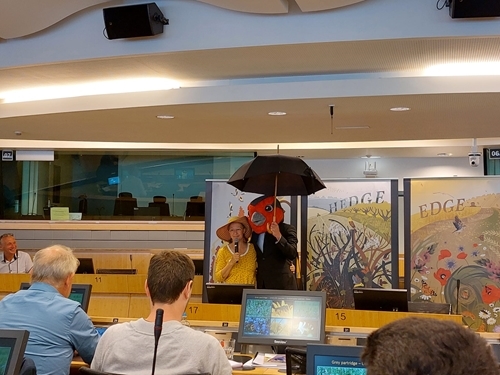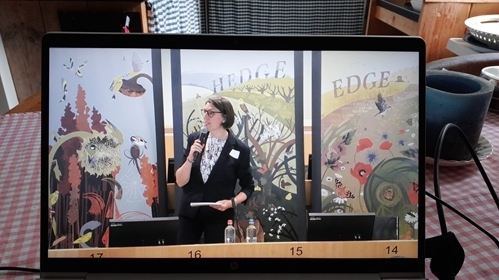
On 30 May, two GWCT-led North Sea Region programme projects, BEESPOKE and PARTRIDGE, held their final conference in Brussels. Farmers, scientists, conservationists, farm advisors, hunters, and policymakers gathered at the Committee of Regions to share their solutions and recommendations to reverse biodiversity loss across the North Sea region and increase wild bee numbers to aid crop pollination.
The two projects use the grey partridge and bees as their respective indicator species to show the impact of good advice, collaboration, and innovation as tools to deliver more nature in the farmed environment.
Speakers were keen to showcase that our biodiversity crisis isn’t just bad news for the birds and the bees, but for mankind as well. “Biodiversity loss is a key threat for humanity,” said Anne-Sophie Mulier, Policy & Project Officer of the European Landowners’ Organisation (ELO) during her introductory keynote speech. The facts she laid out were striking – half of global GDP is linked to nature, with insect pollination worth €15 billion to the EU every single year.
This message was shared by Alia Atitar de la Fuente, of the European Directorate-General for Agriculture and Rural Development (DG Agri), who made it clear that “if we want to continue producing our food, we really need to bring back nature. We cannot produce food without biodiversity”, she said. In a time when food security is high on the political agenda, it is important that we heed her advice and see farmers as the guardians of our land, “but farmers must be rewarded for their efforts and rules must be kept simple and clear, otherwise farmers won’t take part”, emphasised Laurent Govaert, a young farmer from Flanders who took part in both projects.

Despite support and policy from the European Commission, the farmland bird index has fallen by 34% since 1990, with the grey partridge one of the worst affected, and a third of bee species are in decline. What these two projects offer, however, is hope and clear solutions for success.
Under the PARTRIDGE Project, ten 500-hectare demonstration sites have increased wildlife-friendly habitats by an average of 4.5% to an overall 11% in seven years, which is far more than the average 4% on Europe’s farmland. Unsurprisingly, this big difference in the amount of wildlife-friendly habitat set aside for nature at their demo sites, has led to significantly higher diversity and abundance of farmland birds as well as flower-rich pollinator habitats, compared to what is typically found on conventional arable farmland.
The project concluded, that if all arable farmland looked like their ten project sites, the farmland biodiversity crisis would not exist and hence offers a blueprint for policymakers and practitioners to halt and reverse the decline of biodiversity on Britain’s and Europe’s farmland. The secret of their success is to have been able to facilitate stakeholders to work together to deliver for nature, from farmers working together in clusters, supported by advisors, hunters, agronomists, local and national authorities, and the wider public.
There was also a great deal of hard work. Seventy farmers, supported by 615 researchers, students, volunteers, and hunters undertook habitat management and wildlife monitoring to improve the landscape and boost biodiversity. To get an accurate picture of their progress, participants undertook farmland bird monitoring by walking a combined 5,000km, the equivalent of walking from Brussels to Baghdad.
Key to the project’s success was the creation of a specific PARTRIDGE seed mix, which contains almost 30 species of plants, 19 of which are native to Britain. This supports considerably higher insect numbers than a standard wildbird seed mix and has now been adopted by more than 2,000 farmers, thanks to its introduction as an agri-environment scheme option in the Netherlands, Flanders, England and Lower Saxony as a result of the project.

Why did PARTRIDGE choose the grey partridge as their flagship species? In the words of Dr Francis Buner, project lead for PARTRIDGE and a head scientist for the Game & Wildlife Conservation Trust in the UK, “if we do what is right for the grey partridge, we do what is right for farmland biodiversity.”
Recognised as a farmland biodiversity umbrella species, the partridge’s need for good nesting cover, a rich availability of insect life, and protection from predators year-round means that if they are thriving, so too should, in Francis’ words, “bees, birds, mammals and anything that’s crawling on the ground.”
The BEESPOKE project showcases a similar level of innovation, with different seed mix prescriptions for different crops, including soft fruits, top fruit and grassland. This link between supporting pollinators and increasing yields is hoped to encourage farmers to establish new wildflower areas.
Professor John Holland, who led BEESPOKE in the UK, and Dr Michelle Fountain, spoke about the predictive tools they have produced, demonstrating the added value flower strips can provide for farmers and how much habitat is needed to boost pollinators on a local level. Different bees also have different needs, as beekeeper Lotta Fabricus was keen to highlight. Honeybees forage up to 3km, whereas solitary bees are only foraging over 100m. As partridges also have a small range, it is clear that a diverse habitat is essential to deliver these benefits on a local level all year round.

These projects have each shown that there is potential for us to turn around this crisis, but we need much more engagement and ambition. “What we have seen in PARTRIDGE is that we need to increase the scale from the farm to the landscape level”, said Andrea Kuiper of Birdlife Netherlands, and that “it’s really important that we look at farming to restore biodiversity with better AES options available.”
This view was shared by her compatriot Fien Oost, project officer for Brabants Landschap, who made it clear during the project presentation that “in order to be successful, an increased amount of wildlife-friendly habitats is needed to 10% of high-quality habitat to recover farmland wildlife successfully.” David Scallan of FACE, representing the views of the hunters, highlighted how intensification of agriculture had led to the loss of many small game species. He stressed the need for collaboration between all stakeholders across the farmed landscape to help recover farmland biodiversity.
On the ground, it’s essential that farmers are engaged and economically incentivised, and few things have the impact of seeing the impact of their hard work. Laurent Govaert, is clear evidence of that. “We see the effect. A lot of insects, butterflies we’ve never seen before. The effect is real. If you can bring this to the people and the industries using our products, that’s good.”
The conference was concluded by Evelyn Underwood, senior policy analyst from the Institute for European Environmental Policy (IEEP), who repeated the need to make current farmland policies more flexible by being less prescriptive and more focused on results, to offer better advice by combining economics with biodiversity, to increase scale to landscape levels aimed at 10% wildlife-friendly habitats, and the need to work in multidisciplinary groups, in particular facilitating farmer groups or clusters.